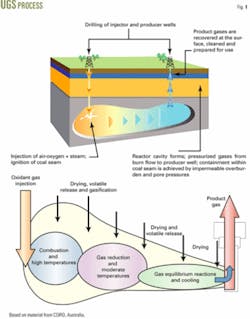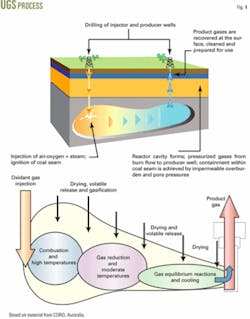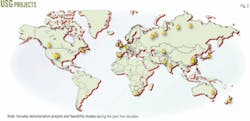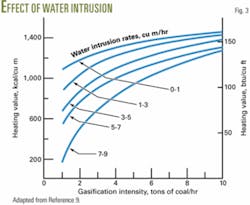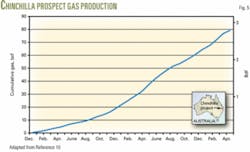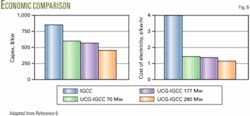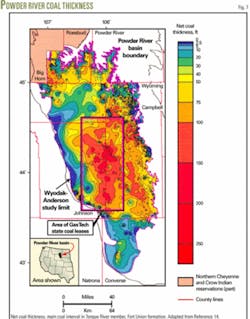Scott L. Montgomery,
Petroleum Consultant,
Seattle, Wash.
Steve Morzenti
GasTech Inc.
Casper, Wyo.
Repeated trial successes and the global need for new energy sources indicate that underground coal gasification (UCG) may be nearing commercialization.
The technology is overcoming previous barriers to commercial development, such as environmental concerns and low energy prices. Compared with surface integrated gasification combined-cycle (IGCC) and, especially, conventional coal-fired stations, UCG marks an improvement in costs, effects, and emissions. UCG represents a technology with considerable potential in power generation, industrial applications, and petrochemical feedstocks.
For nations with large coal resources and declining oil or gas reserves, UCG can transform a dormant resource into economical reserves.
Like many successful technologies, UCG has had a long gestation, with lessons learned and best practices accumulating over time. Several countries have realized this and now moved ahead with development projects.
The US, with its vast coal deposits, technological expertise, and emphasis on clean-coal approaches, is in an excellent position to take advantage of UCG in such areas as the Powder River basin of Wyoming.
Coal
Coal is the world’s most abundant fossil fuel. Estimates place this resource base at 5-18 trillion tons,1 equivalent to 25-92 trillion bbl of oil. On an energy-content basis, proved coal reserves account for about 70% of the world’s fossil-fuel resources.2
Conversion factors include 1 bbl of oil = 5.75 gigajoules, 1 ton of coal = 38.2 gigajoules at 12,500 btu/lb of coal, and 1 Mcf of natural gas = 1 gigajoule.
At present rates of use, the world has enough coal for another 164 years, compared with 40 years for oil and 67 for natural gas. Correlative figures for the US are even more striking: 245 years for coal vs. 11 for oil and 10 for gas.2
Such numbers suggest that considerable effort should and will be made to enhance coal as a vital energy source for the foreseeable future. Large reserves exist in many of the world’s most energy-hungry and technologically advanced regions: India, China, Russia, Australia, EU, and, of course, the US. The US has nearly a third of the world’s coal resource base.
Two obstacles block the full exploitation of coal energy. The first stems from environmental concerns, regarding both solid waste and emissions. These concerns have inspired much research and growing worldwide interest in clean-coal technologies. The second is limited access. Up to 95% of the coal resources are too deep for economic extraction. Mining is confined to basin margins (strip operations) or local intrabasinal areas (underground shafts).
Coalbed methane (CBM) production frees only desorbed gas, which, at an average recovery of 50-600 scf/ton of coal, yields from 50,000 to 600,000 btu/ton, compared with an average of 25 million btu/ton in the coal itself. Clearly, methods for accessing the energy in unworkable coal and dealing adequately with environmental risk deserve significant attention.
One such method, drawing on technology from the petroleum industry, is underground coal gasification (UCG) for gasifying coal in situ and recovering the product at the surface. Little known in the US, UCG is an established approach on the brink of commercialization because of higher energy prices and recent trials abroad.
The US has lagged behind UCG development, yet it offers one of the best resource settings anywhere in the world in thick, extensive coals of Wyoming’s Powder River basin.
UCG
UCG involves the controlled, underground conversion of coal to a combustible gas. Fig. 1 illustrates the basic UCG process which consists of:
• Pumping an oxidant (air or oxygen) and steam down an injection well into the coal seam.
• Igniting the coal.
• Recovering the resulting hot, pressurized gases from a second, producer well.
Breakdown of the coal generates a cavity that grows away from the ignition point, yielding a product gas that includes CH4, H2, CO, and CO2 with minor amounts of impurities. Impermeable overlying rock and pore pressures aid in containing this gas within a flow channel.
Fig. 1 depicts a simple, dual vertical-well scenario. Actual operations typically have employed multiborehole systems, which may include horizontal or deviated wells. Success depends on good communication between the injector and producing well.
Horizontal drilling is one method that helps ensure reliable fluid pathways.
Product gas recovered and cleaned at the surface can either be used in power generation, particularly in turbines designed for combined-cycle power plants, or gas-to-liquids (GTL) production of ultralow-sulfur fuels. Other uses include methanol production, combined heat and power, and hydrogen generation for ammonia synthesis or fuel cells.
UCG gas is similar in composition to gas produced from surface coal gasification. The gas typically has 100-350 btu/scf (10%-30% of natural gas). These calorific values match or exceed those generated with IGCC power plants. UCG gases typically recover as much as 50%-70% of the coal’s original calorific value.
History
Coal gasification started in the 19th century with the production of town gas, derived from the cooking (pyrolysis) of coal. In-seam gasification was pursued in the UK in the 1920s and on a larger scale in the Soviet Union in the 1930s at several sites, some of which produced for more than 50 years. Two projects are still in operation today.
The Soviet projects included multiwell configurations and achieved large-scale power generation, up to 1,200 Mw.3
Trials were carried out in the 1950s in the UK and, more extensively, in the US (for example in the Hanna basin, Wyoming) from the 1970s to the early 1990s. The US projects established commercial feasibility but did not proceed due to low natural gas prices.4 5 These efforts introduced several key innovations, in particular horizontal drilling and a controlled retractable injection point (CRIP), allowing for multiple ignitions along the length of a horizontal wellbore.
Subsequent trial burns in Belgium and Spain between 1992 and 1998, at 860 m and 550 m depths, employed horizontal and CRIP technology and established the feasibility of UCG in deep, thin coals.
Recent higher gas prices have prompted new efforts in many countries, including:
• Power projects in South Africa (1,200 Mw), India (750 Mw), Pakistan, and Canada.
• Feedstock projects in Australia and Canada.
• Feasibility studies in Japan, Ukraine, and New Zealand (Fig. 2).
The UK Department of Trade and Industry has identified UCG combined with carbon capture as a target technology for domestic energy development.6
To date, the most significant new trial has been the Chinchilla project in Queensland, Australia. Operated continuously from 1999 to 2003, Chinchilla produced gas in sufficient quantities to indicate commercial viability. The project met all environmental specifications and had costs comparable to cheaply mined coal.
Technical issues
Field experience from trials on four continents, at depths up to 1,300 m, suggests the importance of several factors for successful UCG exploitation.
Detailed geologic characterization is essential. Such characterization includes analysis of local stratigraphy, structure, geohydrology, and coal data, drawing in part on reservoir characterization techniques adopted from oil and gas exploration (seismic, core data, etc.).
Key criteria for a good UCG site include: adequate coal seam thickness and depth; coal chemistry (ash content <40%); lateral continuity of the coal; limited or no faulting; separation from good-quality ground water; and impermeable and structurally robust overburden.5 6 In general, gas production is greater from more deeply buried coals, due in part to increased pressures.
A major concern in early UCG trials was control of the underground reaction.5 7 The trials showed that such control is achieved best by keeping pressures within the gasification reactor at less than hydrostatic levels, thereby preventing outflow of product gases and contaminants. Control also is aided when temperatures are high enough to vaporize intruding water, which can obstruct gas flow. Changes in injection rate, meanwhile, can control gas production.
Gas-quality targets depend on whether the gas is for fuel gas (power generation) or feedstock gas (syngas). For fuel gas, the issue is calorific value. Evidence indicates that, for a specific coal and depth, this value increases with the proportion of injected oxygen, the injection rate, and, especially, gasification intensity (tons/hour of coal gasified), and decreases with higher water inflow.8
Fig. 3 summarizes these latter effects, showing that increases in gas injection can offset the negative influence of water intrusion. For feedstock gas, on the other hand, the goal is to adjust operations so that the gas contains more hydrogen. A typical optimal H2-CO ratio is 2:1, which usually is achieved with adjustments of the oxygen content in the injected stream. The use of air increases the proportion of N2 relative to H2 in product gases.
An important technical issue concerns the design of a UCG system, for example what type of wells to drill at a specific site.5 6 Experience suggests that vertical wells in a grid pattern are most appropriate for shallower seams (<300 m), while directional holes and CRIP systems work best for deeper coals.5 The cost of horizontal wells in deeper seams compares favorably with drilling more vertical wells for accessing the same coal volume.
Advantages, limitations
In comparison with other clean-coal technologies, UCG has several benefits,4 6 7 including:
• Transforming unexploitable resource into a commercial reserve.
• Eliminating exploration costs.
• Reducing capital costs (no surface plant for coal preparation and gasification).
• Providing 50% less wellhead cost than natural gas, on an energy content basis.
• Minimizing surface disturbance.
• Requiring a smaller labor force and increasing safety (no personnel underground).
• Minimizing waste-disposal requirements (solids remain underground).
• Using less water than CBM operations.
• Accessing coals in offshore, such as in the North Sea.
• Reducing NOx emissions.
• Having a potential for onsite capture and sequestration of CO2 in depleted gasified cavities.
Recent studies show that on the basis of kg CO2/Mw-hr, UCG emissions are comparable with IGCC systems, much lower than for a modern coal-fired thermal (steam-driven) power plant, and somewhat higher than for a natural gas fired plants (Fig. 4).6
Potential limitations for UCG projects mainly relate to environmental issues and possible public perceptions. Early trials observed and analyzed in detail environmental problems, such as groundwater contamination. Recent projects have eliminated these problems through improved design, monitoring, and technology advances.
Several studies of public attitudes towards UCG suggest that the main concerns deal with environmental effects and visual impacts, while the economic advantages, such as local employment, partly offset the concerns.9 The recent Chinchilla project in Australia has had excellent environmental performance with less visual disturbance than CBM operations.
Chinchilla project
The facility in Chinchilla, Australia, about 220 miles west of Brisbane, is the most extensive UCG project to date outside the former Soviet Union. The project involved the participation of Linc Energy (Australia) and Ergo Exergy Technologies Inc. and established significant flows of IGCC-quality gas.
Site characterization began in 1997, with pilot plant construction in late 1999. The project included the drilling of nine vertical production wells into a 10-m thick coal seam at a 140-m depth. During 28 months of continuous flow, these wells yielded a cumulative production of nearly 3 bcf (Fig. 5), indicating the gasification of about 32,000 tons of coal.10
Air injection generated a product gas of about 135 btu/scf at 300° C. and 145-psi pressure. Gas quality remained consistent throughout the entire flow period, and the project had excellent gasifier control.
A controlled operations shutdown in 2002-03 revealed no contamination of groundwater or surface areas, no observable subsidence, and no gas leakage.
The project closely monitored groundwater through a network of 20 wellbores at strategic locations. As of late 2005, the project observed no significant environmental impacts and the project remained in full compliance with government environmental specifications.10
Project performance indicates that the economics of commercialization at Chinchilla are favorable compared with other methods of coal use, including IGCC.
Gas quality was sufficient for existing large turbines. Power-generation efficiency and cost were evaluated for a range of IGCC turbine equipment (5-400 Mw scenarios).10 Fig. 6 shows the estimated economics for three power output levels, compared with an average IGCC plant with surface gasification.
The estimated cost of electricity (COE) was less than $0.02/kw-hr. This is less than indicated in a recent UK study that cites a cost of $0.034/kw-hr for a 300-Mw UCG plant (coal seam of 2.5 m thickness). This cost still compares well with COE for IGCC worldwide, which is about $0.03-0.05/kw-hr.
Present plans for Chinchilla include the construction of an onsite gas-to-liquids plant with a synthetic diesel fuel capacity of 24,000 b/d.
Powder River basin
In view of ongoing efforts in Europe, Australia, South Africa, and elsewhere, the US currently lags behind in UCG development. Emphasis on clean-coal technologies has thus far focused on surface-gasification technologies. This is unfortunate because the US offers some of the most promising areas for UCG in the world.
In particular, the Powder River basin of northeastern Wyoming contains an estimated 510 billion tons of low-sulfur subbituminous coal, of which only 5% is accessible to mining. This resource is the target of an extensive CBM recovery activity that has transformed the basin into a major gas province that produces nearly 1 bcfd.
The coal resource is concentrated in the Tongue River member of the Tertiary Fort Union formation. Flat-lying seams in this interval range from 5 to 60 m in thickness (Fig. 7), averaging 30 m in net coal, at depths of 150-600 m.11 This translates into a resource of 100 million tons/640-acre section.
Many thicker seams have lateral continuity of 25-30 km and are encased in low-permeability siltstones. These data suggest an exceptional setting for UCG exploitation, with high-quality coal, thick roof rock to minimize groundwater inflow and gas loss, and sufficient depth for elevated pressures to enhance production and recovery.
In addition, CBM development in the basin offers several advantages to UCG operations, including the availability of pipelines, power, labor, and other infrastructure, as well as water drawdown in many areas.
At present, one US company, GasTech Inc., Casper, Wyo., has acquired a dominant lease position to implement a UCG project in the basin. GasTech’s position includes 125 sq miles of state-owned coal leases in the area of thicker, deeply buried coals (Fig. 7).
This holding includes coal resource in excess of 13 billion tons, with an average of 16.4 million btu/ton.
The company’s plans include an UCG demonstration project that can be expanded to a commercial facility, either for power generation or GTL operations.✦
References
1. Landis, E.R., and Weaver, J.N., Global coal occurrence; in B.E. Law and D.D. Rice, Hydrocarbons from Coal, AAPG Studies in Geology, Vol. 38, 1993, pp. 1-12.
2. BP Statistical Review of World Energy, 2005.
3. Gregg, D.W., Hill, R.W., and Olness, D.U., An overview of the Soviet effort in underground coal gasification, Lawrence Livermore Laboratory, Livermore, Report UCRL-52004, 1976.
4. International Workshop on Underground Coal Gasification; Department of Trade and Industry (DTI) Conference, Oct. 1-2, 2003, London. Summary of papers available online at: http:/www.dti.gov.uk/energy/coal/cfft/Write_up_of_event.pdf, accessed Feb. 5, 2006.
5. Beath, A., and Su, S., Gasification of Coal In-Situ; Exploration and Mining Report 1110C, CSIRO, 2003.
6. Department of Trade and Industry (DTI), Review of the Feasibility of Underground Coal Gasification in the UK, DTI Report, 2004.
7. Beath, A., et al., Underground coal gasification: evaluating environmental barriers, CSIRO Exploration and Mining Report P2004/5, 2004.
8. Gregg, D.W., and Olness, D.U., Basic principles of underground coal gasification. Lawrence Livermore Laboratory, Livermore, Calif. Report UCRL-52107, 1976.
9. Shackley, S., Reiche, A., and Mander, S., The public perceptions of underground coal gasification (UCG): a pilot study, Tyndall Centre for Climate Change Research, Working Paper 57, UMIST, Manchester, UK, 2004.
10. Blinderman, M., and Jones, R.M., “The Chinchilla IGCC project to date: underground coal gasification and environment,” Gasification Technologies Conference, San Francisco, Oct. 27-30, 2002.
11. Ellis, M., et al., Coal resources, Powder River Basin, Resource assessment of selected Tertiary coal beds and zones in the northern Rocky Mountains and Great Plains region; USGS Professional Paper 1625-A. Available online at http://greenwood.cr.usgs.gov/energy/coal/PP1625A/pp1625A.html. Accessed Jan. 15, 2006.
The authors
Scott L. Montgomery ([email protected]) is a Seattle-based energy consultant and author. He has written on frontier technologies and plays in the petroleum industry for a variety of publications. Montgomery holds a BA in English from Knox College and an MS in geological sciences from Cornell University.
Steve Morzenti (gastech @woldoil.com) is the chief operating officer of GasTech, Casper, Wyo. He is involved in developing GasTech’s underground coal-gasification project in the Powder River basin. He previously worked in mine engineering, development, and operations. Morzenti holds a BS and MS from Lehigh University, Bethlehem, Pa. and is a registered professional engineer and professional geologist.
